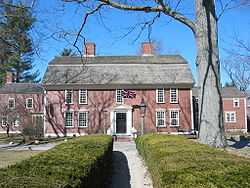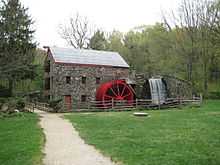Wayside Inn

The Wayside Inn is a historic landmark inn located in Sudbury, Massachusetts. The inn is still in operation, offering a restaurant, historically accurate guest rooms, and hosting for small receptions. It is reputedly the oldest operating inn in the country, opening as Howe's Tavern in 1716.[citation needed] The inn's archive has documents from 1686 onward, including the official inn license granted to the first innkeeper, David Howe, in 1716. Lydia Howe, a granddaughter, was born in the Inn.
History
The inn is also known as Longfellow's Wayside Inn, a name given to the inn to capitalize on the popularity of Henry Wadsworth Longfellow's Tales of a Wayside Inn, a book of poems published in 1863. Longfellow visited the Wayside Inn in 1862, when it was called the How Tavern. In his book Tales of a Wayside Inn, Longfellow republished his poem "Paul Revere's Ride" as "The Landlord's Tale".

Henry Ford built a replica and fully working grist mill and a white non-denominational church, named after his mother, Mary, and mother in law, Martha. Less well known is Ford's attempt to create a reservoir for the Wayside Inn. Across US Rte. 20 and now secluded in a wooded area behind private homes is a 30 ft. high stone dam. Dubbed by the locals as "Ford's Folly" the structure failed to retain water because the feeding brook provided insufficient volume and the ground was too porous for a pond to fill.
In the grounds of the church stands a one-room schoolhouse that was moved there from its original location in Sterling, Massachusetts by Ford, who believed the building was the actual schoolhouse mentioned in Sarah Josepha Hale's poem "Mary Had a Little Lamb", though little historical evidence exists to support his belief.
Establishment as a museum
Henry Ford was the last private owner of the Wayside Inn. He purchased it in 1923, from Cora Lemon, and he also purchased 3,000 acres (12 km²) of land surrounding the Inn, with the aim of developing it into a historically oriented village and museum. Although his original aims were not accomplished at the Wayside, he did establish the non-profit institution that operates the Inn and associated museum, watermill, and archives today. He ultimately fulfilled on his desires to create such a museum at Greenfield Village in Dearborn, Michigan.[1]
Gallery
-

-

The main entrance of the inn
-

-

A marker announcing George Washington's passing through in 1775
-

The Wayside Inn, c. 1935
References
- ↑ Wayside Inn History. Retrieved May 2008.
External links
| Wikimedia Commons has media related to Longfellow's Wayside Inn. |
Coordinates: 42°21′26″N 71°28′6″W / 42.35722°N 71.46833°W